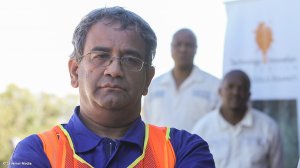JOHANNESBURG (miningweekly.com) – Gold mining company AngloGold Ashanti has begun consulting with employees on placing the 59-year-old Savuka mine and the 36-year-old Kopanang mine on care and maintenance, and evaluating the integration of the 60-year-old TauTona mine into the neighbouring Mponeng mine, which is being set up as a new, lower-cost operation.
On a gold price that averaged $1 216/oz, TauTona and Kopanang recorded all-in first-quarter sustaining costs of $1 737/oz and $2 399/oz after also being lossmaking in 2016.
“It’s critical that we act,” AngloGold Ashanti CEO Srinivasan Venkatakrishnan (Venkat) said on Wednesday, when he emphasised the need to protect long-term sustainability as well as the majority of the South African workforce, which currently totals 28 000, including contractors.
While 8 500 roles across the South African business are coming under intense scrutiny, the Johannesburg Stock Exchange-listed company underscored its determination to limit job loss to an absolute minimum.
The Savuka section in question has already been extended ten years beyond its natural life and Kopanang produced its first gold in 1981.
These changes will also take in a review of regional support services and overhead costs.
The mines earmarked for care and maintenance have for some time faced ore-reserve depletion, increasing depth, growing distance from central infrastructure, declining production profiles and cost escalations that have continued to outpace both inflation and a subdued gold price.
Venkat said the “difficult decision” followed a period of “significant and ultimately unsustainable losses”, coupled to the evaluation of options of returning the South African business to profitability safely.
“We’re mindful of the sensitivity that this situation demands, and we’re committed to supporting all our employees throughout this process,” he added in a media release to Creamer Media’s Mining Weekly Online.
Consultation with organised labour groups under section 189 and 189A of the Labour Relations Act would, he said, be facilitated under the auspices of the Council for Conciliation, Mediation and Arbitration.
AngloGold, which has 17 gold mines in nine countries, as well as exploration programmes in both the established and new gold-producing regions of the world, indicated earlier this year that it would be reviewing its South African operations owing to the heavy, and ultimately unsustainable, losses they had incurred.
The more immediate of its key long-term projects is the Mponeng Phase 1 project, which together with Guinea's Siguiri gold mine and the Democratic Republic of Congo's Kibali joint venture, is giving the company line of sight to a better portfolio, backed by continued exploration successes.
The Mponeng deepening project will extend development of the world’s deepest mine to 123 level and 126 level.
AngloGold COO Chris Sheppard said in response to Mining Weekly Online in May that production had already begun on 123 level as part of the first phase, with full ramp-up scheduled to take place through this year and next year.
He said that the so-called above-120-level 'old mine' would reach the end of its ore-reserve position within the next four years.
“So, within the next three- to four-year horizon, we’re going to see the entire production load for Mponeng being generated on the Phase 1 horizon,” Sheppard added.
What was called a Phase 2 project is being restudied to find the most optimal way of investing into the promising orebody.
Mponeng is being set up as a new, lower-cost mine, with the company, in the words of its CEO, “redefining what is possible" at ultra-depth.
Rather than using large capital investments, the company is continuing to pursue lasting operational improvement through innovation.
In the first three months of this year, AngloGold produced 830 000 oz at $813/oz, down on 861 000 oz at $702/oz in the first quarter of 2016, with costs pushed higher by lower grades and significantly stronger currencies in key operating regions.
With the exception of Mponeng, AngloGold's South Africans mines had a poor start to 2017, when a 16% stronger rand drove up all-in sustaining costs in South Africa to “unacceptable levels”.
Mponeng remains the strongest asset in the portfolio, with Moab Khotsong a close second, despite its underperformance in the first three months to the end of March.
Apart from Mponeng, the balance of AngloGold’s South African underground portfolio has been suffering from a lack of mineable face length, which has the capability of increasing volume and offering the flexibility that is needed for consistent performance.
While advancing lower-capital, quicker-payback projects on a self-funded basis, exploration for longer-term replenishment has been refocused on Guinea, Tanzania, Australia and Colombia.
The company produced 3.628-million ounces of gold last year, when it generated $4.08-billion in gold income on $811-million worth of capital expenditure.
The company has an attributable ore reserve of 50.1-million ounces of gold and an attributable mineral resource of 214.7-million ounces.
Edited by: Creamer Media Reporter
EMAIL THIS ARTICLE SAVE THIS ARTICLE
ARTICLE ENQUIRY
To subscribe email subscriptions@creamermedia.co.za or click here
To advertise email advertising@creamermedia.co.za or click here













